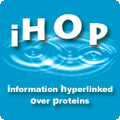Protein-protein interaction databases
| Name | Description | Link |
|---|---|---|
| GPS-Prot |
Comprehensive protein-protein interactions; excellent ease of use and completeness, data visualization | http://gpsprot.org/ |
| Wiki-Pi |
A web resource for human protein-protein interactions; excellent search results | http://severus.dbmi.pitt.edu/wiki-pi/ |
| String |
database of experimental and predicted interactions; excellent graphics | http://string-db.org/ |
| IntAct |
derived from literature curation or direct user submissions; tables | http://www.ebi.ac.uk/intact/ |
| iHOP |
= information hyperlinked over proteins; built by literature mining; results as text clippings | http://www.ihop-net.org/ |
| BioGRID |
from literature & high-throughput datasets; best for yeast & A. thaliana | http://thebiogrid.org/ |
| MIPS |
Mammalian Protein-Protein Interaction Database (didn't work when tested in Sept '11) | http://mips.helmholtz-muenchen.de/proj/ppi/ |
| Mentha | mentha archives evidence collected from different sources and presents these data in a complete and comprehensive way | http://mentha.uniroma2.it/index.php |
| add another | database here with description here | link |
- GPS-Prot allows easy querying and display of human PPIs aggregated from all major databases
- Includes BioGrid, DIP, IntACT, HPRD, MINT, BIND, MIPS and more
- Each interaction comes with a link to publications in chronological order on PubMed. Access the entire publication history for any interaction.
- Experimental techniques curated from the literature are listed for each interaction (e.g. Affinity Chromatography, X-ray crystallography).
Opinion: strong on ease of use and completeness, allows anyone, from students to experts, to view a PPI network easily
- Wiki-Pi's intuitive search functionality allows you to retrieve and discover interactions effectively
- interaction is provided with automatically updated annotations of individual proteins from databases such as Gene Ontology, KEGG, REACTOM, Pubmed2ENSEMBL, and DrugBank
- search for interaction with simple queries such as associations to diseases or pathways, or complex queries conditioned on annotations of one or both proteins in the interaction
- latest references: [1]
Opinion: great search results, good tabular representation.


- collects evidence from genomic Context, high-throughput experiments, conserved coexpression, and text mining
- created by CPR, EMBL, SIB, KU, TUD, and UZH
- latest references: [2], [3]
Opinion: easy to use, great graphical interaction map, detailed explanation of evidence

- data from the literature or from direct data depositions by expert curators
- <300k binary interactions in 2011
- developed by the EBI's Proteomics Services Team
- recent reference: Aranda et al. '10
Opinion: The default is an oversized results table (>2 screen widths on a 13"). Use "Change table presets" to compact. Separate columns for links/alias/pubID could be integrated or hover over to make the default table easier on the eye. Overall, the presentation of results seems to be more geared towards bioinformaticians than users with the table full of codes instead of names (Do you know what 9606 is?). Also, no easy species selection and, more importantly, no graphical overview.

- genes and proteins converted into hyperlinks between sentences from PubMed & turned into a conceptual network
- originally developed at CNB-CSIC, authors now at CNIO & MIT
- references: Hoffmann & Valencia 2004 Fernández et al. 2007
Opinion: All information is presented as highlighted text in sentences which makes the information slower to take in than from a structured table and much slower than from a graphical representation. Hypothetical and possibly indirect interactions (A regulates B), non-existent interactions (A does not bind B), and experimental (A co-precipitates with B) are not differentiated. Easy to use, clean species separation.

- >400k interactions curated from both high-throughput datasets and primary literature
- mostly developed by researchers from Edinburgh, Princeton, and Toronto [4]
- recent references: The BioGRID Interaction Database: 2011 update, A global protein kinase and phosphatase interaction network in yeast. Breitkreutz et al. '10
Opinion: Good interface but generally fewer hits than other databases for mammalian genes. This is probably because this database contains mainly yeast protein interactions where it is very strong. It is currently being extended towards other metazoans. Nice representation of evidence as high & low throughput with reference and description.
See also
On OpenWetWare
- The Prince lab present on OWW works on protein-protein interactions.
- OWW's Keating lab also works on protein-protein interactions.
Lists of protein interaction resources:
- huge collection of protein interaction resources at the FLI
- interaction database list by the Finley lab
- MIPS (scroll down to other resources)
Related literature searches
Recent reviews:
- Databases of protein-protein interactions and complexes. Ooi et al. 2010
- Computational prediction of protein-protein interactions. Skrabanek et al. 2008
- ..the Human Proteotheque Initiative (HuPI). Coulombe et al. 2008
Wikipedia entry protein interaction, interaction prediction